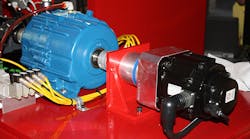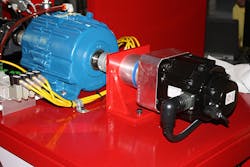A major manufacturer of lacrosse equipment wanted to test the durability of its lacrosse sticks in game-like settings to ensure they could withstand the use, and abuse, without breaking and creating a danger on field. The firm wanted a machine that could automatically test equipment. It also needed to mimic human reactions when striking stationary objects. In other words, the driving force on the stick had to stop quickly when an immovable object was hit, just like a player would stop his swing if he slammed it into a goal post.
The company soon teamed with Automated Design Corp., Romeoville, Ill., a company that has developed and manufactured a host of automated testing machines for sports equipment. The final testing “robot” consists of a Yaskawa SGMGV-13 servo motor, GAM EPL-W-084-003G planetary reducer with servo adaptor, the Force Control Posidyne clutch-brake, and an encoder.
When it’s in action, the motor drives a lacrosse stick into an anvil at up to 130 mph thousands of times per day. The oil shear clutch-brake from Force Control Industries, Fairfield, Ohio, disengages the motor when the stick hits an anvil or slams its mid-stick section into a post (to simulate a stick-on-stick hit).
A servo running into the input of the clutch-brake lets the equipment maker decide at what degree they want the clutch to be released, at which point the stick goes into “free fall” mode, bouncing around within its arc until the clutch is re-engaged and the process repeated.
“The advantage of the oil-shear clutch is that it gives us accurate, repeatable positioning,” says Automated Design Project Manager Joe Bitsky. “No matter how many times we engage the clutch, it stays in a consistent position.”
Oil-shear technology also ensures the test stand can operate continuously, without adjustment. It lets a film of automatic-transmission fluid flow between the friction surfaces. Then, when the clutch is engaged, that fluid gets compressed. Particles in the fluid transmit torque to the other side when they are in shear. This torque turns the stationary surface, bringing it up to the same speed as the moving surface. Because most of the work is done by fluid particles in shear, there is little wear in the short time it takes for the surfaces to actually meet or “lock up.” And when they do lock up, it is a “cushioned” engagement that reduces shock to the motor and extends its service life.
Unlike dry clutches, the totally enclosed oil-shear clutch is impervious to external elements such as wet, dusty, or dirty environments.
In addition to transmitting torque, the fluid dissipates heat, thanks to a patented fluid recirculation system, and keeps all components lubricated.
“The system has been operating for just over three years,” says Bitsky. “And we’ve never had a single call from the customer.”
Bitsky estimates the company’s two lacrosse-testing machines have over a million cycles on them and continue to operate without incident. In fact, the versatile design and precise positioning and repeatability of the clutch-brake let the test stands be used for throw testing, part of the durability testing regimen for lacrosse balls.
“When we’re not banging lacrosse sticks, we use the test stand for throw studies,” he says. “We want to be able to make it spin any way we want—and the clutch lets us do that.”

